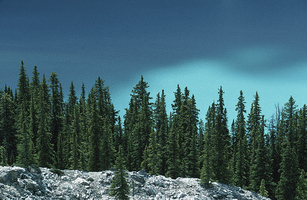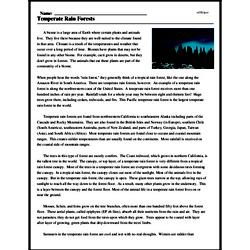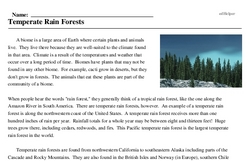Temperate Rain Forests
A biome is a large area of Earth where certain plants and animals live. They live there because they are well-suited to the climate found in that area. Climate is a result of the temperatures and weather that occur over a long period of time. Biomes have plants that may not be found in any other biome. For example, cacti grow in deserts, but they don't grow in forests. The animals that eat these plants are part of the community of a biome.
When people hear the words "rain forest," they generally think of a tropical rain forest, like the one along the Amazon River in South America. There are temperate rain forests, however. An example of a temperate rain forest is along the northwestern coast of the United States. A temperate rain forest receives more than one hundred inches of rain per year. Rainfall totals for a whole year may be between eight and thirteen feet! Huge trees grow there, including cedars, redwoods, and firs. This Pacific temperate rain forest is the largest temperate rain forest in the world.
Temperate rain forests are found from northwestern California to southeastern Alaska including parts of the Cascade and Rocky Mountains. They are also found in the British Isles and Norway (in Europe), southern Chile (South America), southeastern Australia, parts of New Zealand, and parts of Turkey, Georgia, Japan, Taiwan (Asia), and South Africa (Africa). Most temperate rain forests are found close to oceans and coastal mountain ranges. This creates milder temperatures than are usually found on the continents. More rainfall is received on the coastal side of mountain ranges.




